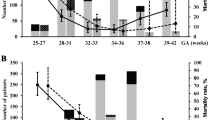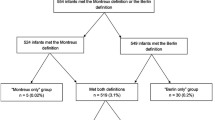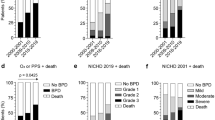Abstract
The frequency of non-invasive respiratory support use has increased in neonates of all gestational ages with respiratory distress (RD). However, the impact of delayed initiation of non-invasive respiratory support in outborn neonates remains poorly understood. This study aimed to identify the impact of the delayed initiation of non-invasive respiratory support in outborn, late-preterm, and term neonates. Medical records of 277 infants (gestational age of ≥ 35 weeks) who received non-invasive respiratory support as primary respiratory therapy < 24 h of age between 2016 and 2020 were retrospectively reviewed. Factors associated with respiratory adverse outcomes were investigated in 190 outborn neonates. Infants with RD were divided into two groups: mild (fraction of inspired oxygen [FiO2] ≤ 0.3) and moderate-to-severe RD (FiO2 > 0.3), depending on their initial oxygen requirements from non-invasive respiratory support. The median time for the initiation of non-invasive respiratory support at a tertiary center was 3.5 (2.2–5.0) h. Male sex, a high oxygen requirement (FiO2 > 0.3), high CO2 level, and respiratory distress syndrome were significant factors associated with adverse outcomes. Subgroup analysis revealed that in the moderate-to-severe RD group, delayed commencement of non-invasive respiratory support (≥ 3 h) was significantly associated with pulmonary air leakage (p = 0.033).
Conclusion: Our study shows that outborn neonates with moderate-to-severe RD, who were treated with delayed non-invasive respiratory support, were associated with an increased likelihood of pulmonary air leakage. Additional prospective studies are required to establish the optimal timing and methods of non-invasive respiratory support for outborn, late-preterm, and term infants.
What is Known: • Non-invasive respiratory support is widely used in neonates of all gestational ages. • Little is known on the impact of delayed initiation of non-invasive respiratory support in outborn, late preterm, and term neonates. | |
What is New: • Male sex, high oxygen requirement (FiO2 >0.3), high initial CO2 level, and respiratory distress syndrome significantly correlated with adverse outcomes. • Outborn late-preterm and term neonates with high oxygen requirement who were treated with delayed non-invasive respiratory support indicated an increased likelihood of pulmonary air leakage. |


Similar content being viewed by others

Availability of data and material
The datasets used and/or analyzed during the current study are available from the corresponding author on reasonable request.
Code availability
Not applicable.
Abbreviations
- BiPAP:
-
Biphasic positive airway pressure
- CPAP:
-
Continuous positive airway pressure
- DR:
-
Delivery room
- FiO2 :
-
Fraction of inspired oxygen
- HHFNC:
-
Humidified high flow nasal cannula
- NICU:
-
Neonatal intensive care unit
- NIPPV:
-
Nasal intermittent positive pressure ventilation
- NPPV:
-
Non-invasive positive pressure ventilation
- NRP:
-
Neonatal resuscitation program
- OR:
-
Odds ratio
- PEEP:
-
Positive end-expiratory pressure
- RD:
-
Respiratory distress
- RDS:
-
Respiratory distress syndrome
- SD:
-
Standard deviation
- S/F:
-
Peripheral saturation/FiO2 ratio
- sNIPPV:
-
Synchronized nasal intermittent positive pressure ventilation
- Ti:
-
Inspiratory time
- TTN:
-
Transient tachypnea of the newborn
References
Reuter S, Moser C, Baack M (2014) Respiratory distress in the newborn. Pediatr Rev 35:417–428; quiz 429. https://doi.org/10.1542/pir.35-10-417
Qian L, Liu C, Zhuang W et al (2008) Neonatal respiratory failure: a 12-month clinical epidemiologic study from 2004 to 2005 in China. Pediatrics 121:e1115-1124. https://doi.org/10.1542/peds.2006-2426
Consortium on Safe L, Hibbard JU, Wilkins I et al (2010) Respiratory morbidity in late preterm births. JAMA 304:419–425. https://doi.org/10.1001/jama.2010.1015
Pramanik AK, Rangaswamy N, Gates T (2015) Neonatal respiratory distress: a practical approach to its diagnosis and management. Pediatr Clin North Am 62:453–469. https://doi.org/10.1016/j.pcl.2014.11.008
Wyckoff MH, Aziz K, Escobedo MB, Kapadia VS, Kattwinkel J, Perlman JM, Simon WM, Weiner GM, Zaichkin JG (2015) Part 13: Neonatal resuscitation: 2015 American Heart Association guidelines update for cardiopulmonary resuscitation and emergency cardiovascular care. Circulation 132:S543-560. https://doi.org/10.1161/cir.0000000000000267
Aziz K, Lee CHC, Escobedo MB et al (2021) Part 5: Neonatal resuscitation 2020 American Heart Association guidelines for cardiopulmonary resuscitation and emergency cardiovascular care. Pediatrics 147. https://doi.org/10.1542/peds.2020-038505E
Spillane NT, Macalintal F, Nyirenda T, Golombek SG (2021) What happens to 35 week infants that receive delivery room continuous positive airway pressure? J Perinatol. https://doi.org/10.1038/s41372-020-00883-w
Moresco L, Romantsik O, Calevo MG, Bruschettini M (2020) Non-invasive respiratory support for the management of transient tachypnea of the newborn. Cochrane Database Syst Rev 4:Cd013231. https://doi.org/10.1002/14651858.CD013231.pub2
Cimino C, Saporito MAN, Vitaliti G, Pavone P, Mauceri L, Gitto E, Corsello G, Lubrano R, Falsaperla R (2020) N-BiPAP vs n-CPAP in term neonate with respiratory distress syndrome. Early Hum Dev 142:104965
Buckmaster AG, Arnolda G, Wright IM, Foster JP, Henderson-Smart DJ (2007) Continuous positive airway pressure therapy for infants with respiratory distress in non tertiary care centers: a randomized, controlled trial. Pediatrics 120:509–518. https://doi.org/10.1542/peds.2007-0775
Frey B, Shann F (2003) Oxygen administration in infants. Arch Dis Child Fetal Neonatal Ed 88:F84-88. https://doi.org/10.1136/fn.88.2.f84
Ho JJ, Subramaniam P, Sivakaanthan A, Davis PG (2020) Early versus delayed continuous positive airway pressure (CPAP) for respiratory distress in preterm infants. Cochrane Database Syst Rev 10:Cd002975. https://doi.org/10.1002/14651858.CD002975.pub2
Schmölzer GM, Kumar M, Pichler G, Aziz K, O’Reilly M, Cheung PY (2013) Non-invasive versus invasive respiratory support in preterm infants at birth: systematic review and meta-analysis. BMJ 347:f5980. https://doi.org/10.1136/bmj.f5980
Miksch RM, Armbrust S, Pahnke J, Fusch C (2008) Outcome of very low birthweight infants after introducing a new standard regime with the early use of nasal CPAP. Eur J Pediatr 167:909–916. https://doi.org/10.1007/s00431-007-0646-1
Smithhart W, Wyckoff MH, Kapadia V, Jaleel M, Kakkilaya V, Brown LS, Nelson DB, Brion LP (2019) Delivery room continuous positive airway pressure and pneumothorax. Pediatrics 144. https://doi.org/10.1542/peds.2019-0756
Clevenger L, Britton JR (2017) Delivery room continuous positive airway pressure and early pneumothorax in term newborn infants. J Neonatal Perinatal Med 10:157–161. https://doi.org/10.3233/npm-171694
Hishikawa K, Goishi K, Fujiwara T, Kaneshige M, Ito Y, Sago H (2015) Pulmonary air leak associated with CPAP at term birth resuscitation. Arch Dis Child Fetal Neonatal Ed 100:F382-387. https://doi.org/10.1136/archdischild-2014-307891
Mukerji A, Abdul Wahab MG, Razak A, Rempel E, Patel W, Mondal T, Beck J (2021) High CPAP vs. NIPPV in preterm neonates — a physiological cross-over study. J Perinatol 41:1690–1696. https://doi.org/10.1038/s41372-021-01122-6
Iyer NP, Mhanna MJ (2016) Association between high-flow nasal cannula and end-expiratory esophageal pressures in premature infants. Respir Care 61:285–290. https://doi.org/10.4187/respcare.04317
Shin J, Park K, Lee EH, Choi BM (2017) Humidified high flow nasal cannula versus nasal continuous positive airway pressure as an initial respiratory support in preterm infants with respiratory distress: a randomized, controlled non-inferiority trial. J Korean Med Sci 32:650–655. https://doi.org/10.3346/jkms.2017.32.4.650
Osman AM, El-Farrash RA, Mohammed EH (2019) Early rescue Neopuff for infants with transient tachypnea of newborn: a randomized controlled trial. J Matern Fetal Neonatal Med 32:597–603. https://doi.org/10.1080/14767058.2017.1387531
Chiruvolu A, Claunch KM, Garcia AJ, Petrey B, Hammonds K, Mallett LH (2021) Effect of continuous positive airway pressure versus nasal cannula on late preterm and term infants with transient tachypnea of the newborn. J Perinatol. https://doi.org/10.1038/s41372-021-01068-9
Gulczyńska E, Szczapa T, Hożejowski R, Borszewska-Kornacka MK, Rutkowska M (2019) Fraction of inspired oxygen as a predictor of CPAP failure in preterm infants with respiratory distress syndrome: a prospective multicenter study. Neonatology 116:171–178. https://doi.org/10.1159/000499674
Hegyi T, Hiatt IM (1981) The effect of continuous positive airway pressure on the course of respiratory distress syndrome: the benefits on early initiation. Crit Care Med 9:38–41. https://doi.org/10.1097/00003246-198101000-00009
Allen LP, Reynolds ER, Rivers RP, Le Souëf PM, Wimberley PD (1977) Controlled trial of continuous positive airway pressure given by face mask for hyaline membrane disease. Arch Dis Child 52:373–378. https://doi.org/10.1136/adc.52.5.373
Nilsson R, Grossmann G, Robertson B (1980) Bronchiolar epithelial lesions induced in the premature rabbit neonate by short periods of artificial ventilation. Acta Pathol Microbiol Scand A 88:359–367. https://doi.org/10.1111/j.1699-0463.1980.tb02507.x
Nilsson R, Grossmann G, Robertson B (1908) Artificial ventilation of premature newborn rabbits: effects of positive end-expiratory pressure on lung mechanics and lung morphology. Acta Paediatr Scand 69:597–602. https://doi.org/10.1111/j.1651-2227.1980.tb07328.x
Hirata K, Nozaki M, Mochizuki N, Hirano S, Wada K (2019) Impact of time to neonatal transport on outcomes of transient tachypnea of the newborn. Am J Perinatol 36:1090–1096. https://doi.org/10.1055/s-0038-1676490
Boo NY, Cheah IG, Malaysian National Neonatal R (2011) Risk factors associated with pneumothorax in Malaysian neonatal intensive care units. J Paediatr Child Health 47:183–190. https://doi.org/10.1111/j.1440-1754.2010.01944.x
Duong HH, Mirea L, Shah PS, Yang J, Lee SK, Sankaran K (2014) Pneumothorax in neonates: Trends, predictors and outcomes. J Neonatal Perinatal Med 7:29–38. https://doi.org/10.3233/npm-1473813
Trevisanuto D, Doglioni N, Ferrarese P, Vedovato S, Cosmi E, Zanardo V (2005) Neonatal pneumothorax: comparison between neonatal transfers and inborn infants. J Perinat Med 33:449–454. https://doi.org/10.1515/jpm.2005.079
Cornette L, Mulder A, Debeer A, Malfilâtre G, Rigo V, Cools F, Danhaive O (2021) Surfactant use in late preterm infants: a survey among Belgian neonatologists. Eur J Pediatr 180:885–892. https://doi.org/10.1007/s00431-020-03806-1
Shin JE, Yoon SJ, Lim J, Han J, Eun HS, Park MS, Park KI, Lee SM (2020) Pulmonary surfactant replacement therapy for respiratory distress syndrome in neonates: a nationwide epidemiological study in Korea. J Korean Med Sci 35:e253. https://doi.org/10.3346/jkms.2020.35.e253
Fang JL, Mara KC, Weaver AL, Clark RH, Carey WA (2020) Outcomes of outborn extremely preterm neonates admitted to a NICU with respiratory distress. Arch Dis Child Fetal Neonatal Ed 105:33–40. https://doi.org/10.1136/archdischild-2018-316244
Siegler Y, Weiner Z, Solt I (2020) ACOG Practice Bulletin No. 217: Prelabor rupture of membranes. Obstet Gynecol 136:1061. https://doi.org/10.1097/AOG.0000000000004142
Lee MJ, Choi EK, Park KH, Shin J, Choi BM (2020) Effectiveness of nCPAP for moderate preterm infants compared to BiPAP: a randomized, controlled non-inferiority trial. Pediatr Int 62:59–64. https://doi.org/10.1111/ped.14061
Author information
Authors and Affiliations
Contributions
Eui Kyung Choi: Primary author, Data collection, Data analysis, Manuscript writing. Kyu Hee Park: Data collection. Byung Min Choi: Drafting of the manuscript, Editing, Critical revision of the manuscript, Responsible for the overall content. All authors provided contributions, read, and approved the final version.
Corresponding author
Ethics declarations
Ethics approval
This study was approved by the Institutional Research Ethics Committee of the Korea University Ansan Hospital (2021AS0193).
Consent to participate
Patient consent was waived due to retrospective study design.
Consent for publication
Written informed consent for publication was obtained from all authors.
Conflict of interest
The authors declare no competing interests.
Additional information
Communicated by Daniele De Luca
Publisher's Note
Springer Nature remains neutral with regard to jurisdictional claims in published maps and institutional affiliations.
Supplementary information
Below is the link to the electronic supplementary material.
Rights and permissions
About this article
Cite this article
Choi, E.K., Park, K.H. & Choi, B.M. Association of delayed initiation of non-invasive respiratory support with pulmonary air leakage in outborn late-preterm and term neonates. Eur J Pediatr 181, 1651–1660 (2022). https://doi.org/10.1007/s00431-021-04317-3
Received:
Revised:
Accepted:
Published:
Issue Date:
DOI: https://doi.org/10.1007/s00431-021-04317-3



